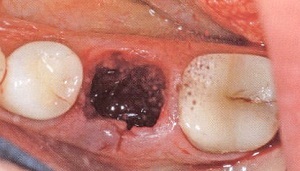 Alveolitis is a complication that occurs after tooth extraction, or several at once. The latter option is increasingly rare, but still possible.
Alveolitis is a complication that occurs after tooth extraction, or several at once. The latter option is increasingly rare, but still possible.
The technical basis of the alveolitis - an inflammatory process in the socket of the removed tooth, is the destruction of the walls of the alveolus hole during the extraction of the tooth, sometimes reaching considerable dimensions, up to the complete breakdown of its walls with the entry of bone fragments into the wound channel.
Contents
- Who is to blame - the question is not simple
- The responsibility of the dentist
- The patient's wounds
- The forms of the disorder and the symptomatology
- To diagnose
- The complex approach to therapy
- Prevention measures
Who is to blame - the question is not simple
The development of this complication does not necessarily occur if the doctor ignores itprescribed rules for tooth extraction.
The tooth to be removed can be technically complex: located in a hard-to-reach area that has an anomaly of roots or additional, over-standard roots. And, despite the high level of development of modern surgical dentistry, the onset of extraordinary situations that require a doctor of the highest art when removing from the gums of the tooth is still possible.
No less important is the need for emergency removal when developing in the tooth, gum or jaw of purulent-destructive changes. The changes that lead to the fragility of the walls of the hole are already pathological.
It can also be caused by the general process leading to increased fragility of the alveolar walls:
- with oncological or other debilitating disease ( AIDS, tuberculosis, systemic connective tissue disease, blood disease, diabetes mellitus);
- exacerbation of chronic or acute disease, or the presence of dormant chronic infections in nearby areas, which leads to a weakening of the protective capabilities of oral tissues.
The responsibility of the dentist
The dentist is responsible in case of leaving a missing fragment of the tooth root in the hole, a fragment of the well wall - 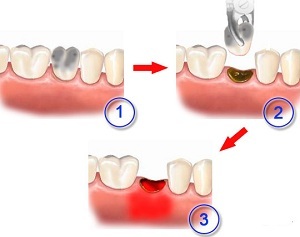 , the presence of a foreign body in the hole after removal of the tooth leads to the non-healing of the wound and its inflammation and alveolitis. In addition, the result is the leaving in the hole of the successfully removed tooth of the dental cyst or granuloma.
, the presence of a foreign body in the hole after removal of the tooth leads to the non-healing of the wound and its inflammation and alveolitis. In addition, the result is the leaving in the hole of the successfully removed tooth of the dental cyst or granuloma.
Another error is not keeping the time necessary for the formation of a blood clot in the hole - the doctor must make sure that it is filled with blood, the clot is formed, and only after that, the plastering is done, the dry hole will necessarily cause an inflammatory process.
In the case of a purulent process that necessitated the removal of the tooth, the doctor should prescribe a program of antiseptic treatment of the oral cavity after the operation and follow its implementation.
The patient's
wines The patient himself is not less responsible for the development of the alveolitis of the tooth.
Excessive nervousness due to the appearance of a "defect" in the mouth with an infinite gaze in the mirror of the "affected" gum area with restless unconscious touches of the wound with fingers and tongue. Or the use of various improvised home remedies out of a desire to heal the wound as soon as possible.
Excessive zeal for rinsing the mouth, leading to rinsing of the blood convolution, which serves as the basis for the formation of scar tissue in the subsequent time. All this, as well as ignoring the recommendations of the doctor for oral care, can lead to additional damage to the mucous gums, cause inflammation and infection of deeper tissues. Up to the bone tissue.
A serious complication even after safely produced extraction is the lack of formation in the alveolus of a blood clot-clot that blocks access to the tissues of the pathogenic flora. A patient who has not informed the dentist that he has a bleeding pathology or that takes anticoagulants, unconsciously creates an additional risk of developing the alveolitis in the postoperative period.
Forms of disorder and symptomatology
Depending on the depth and width of the zone of inflammatory changes, the alveolitis may be:
- serous;
- purulent;
- is purulent-necrotic.
The photo-selection shows step by step the development of the alveolitis - a hole formed after tooth extraction, development of inflammation and completely dry hole:
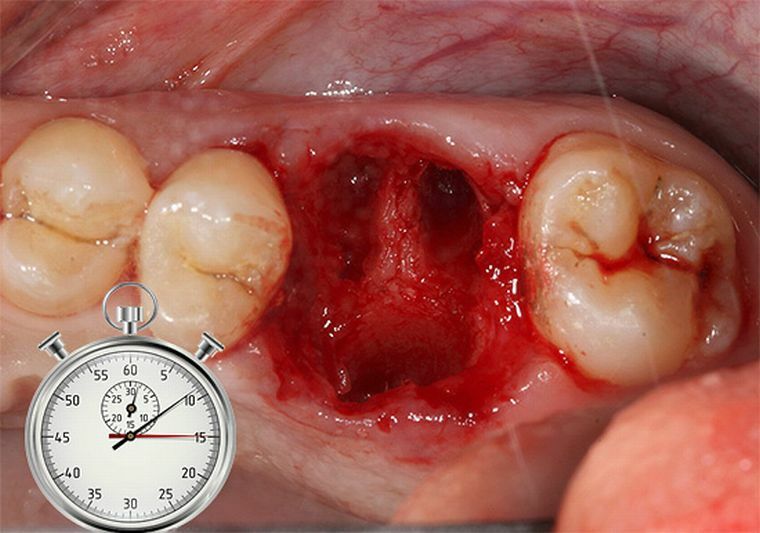


. Two forms of the disease are also distinguished:
- acute;
- is chronic.
Common symptoms are:
- increasing local tenderness with a tendency to expand the pain zone:
- changes in the inflammatory nature of the mucosa.
Dry hole, serving as an entrance gate for infection, promotes the formation of a purulent or purulent necrotic focus. In this case, signs of increasing intoxication with an increase in temperature and cerebral symptoms in the form of headache( up to nausea causing), weakness, lethargy, aches in the whole body and in the facial musculature are added to the general symptoms of the disease.
Serous alveolitis manifests itself 2-3 days after extraction of the tooth with local, lunochkovaya pain, and if it is ignored by the growing symptomatology involving the painful area of the entire jaw, with the irradiation of pain in the temporal zone and the ear.
Inflammation in the area of the hole after removal of the tooth is manifested more or less by the degree of local hyperemia and swelling of the tissues of its walls, expressed by local soreness, which is strengthened when touched.
Involvement in the inflammatory process of ever wider and deeper zones of the jaw during the transition of serous alveolitis to purulent is accompanied by intensification of pain sensations. The appearance of difficulties with the opening of the mouth becomes a consequence of intoxication, leading to a change in metabolic processes both in muscles and in other tissues.
 The hyperemia and puffiness of the gum tissue, which does not allow examining the affected dental alveolus, the purulent or putrefactive odor emanating from it, is an important reason for immediate treatment for specialized medical( dental) care.
The hyperemia and puffiness of the gum tissue, which does not allow examining the affected dental alveolus, the purulent or putrefactive odor emanating from it, is an important reason for immediate treatment for specialized medical( dental) care.
An even greater increase in the picture of the disease with the detection of signs of osteomyelitis on X-rays indicates the transition of the local process to a common one, involving all the jaw tissues with purulent-necrotic character of their defeat.
Dry hole, as one of the main manifestations of the alveolitis - is a dental cell or empty, without blood convolution, with traces of fibrin( scrapes of yellowish or whitish color) and unprotected food residues, or filled with blood clot decomposition products with a purulent or putrefactive odor, bright hyperemiaedematous mucous membrane of the gum, which is very painful when touched. In advanced cases, the swelling of the mucous gum extends to the cheek and other soft facial tissues.
For the diagnosis of
The picture of the alveolitis( both serous and purulent) is not usually caused by a dentist, in view of the fact that the symptoms are very typical and eloquent. 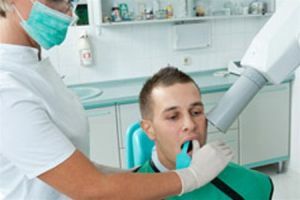
But in order to clarify the diagnosis, it is necessary to apply either X-ray methods for studying the hard tissues of the jaw, or their modern analogues( MRI, CT), which allow to detect a change in the structure of the bone or detect the focus of its destruction-osteomyelitis of the jaw.
In the purulent nature of the process, a general blood test reveals signs of a typical inflammatory process: leukocytosis with neutrophilia, acceleration of ESR.
Self-diagnosis before a visit to a doctor should be limited to examining the well when it is located in an accessible place and comparing the temperature with normal readings.
Integrated approach to the therapy of
In patients with serous alveolitis, conservative non-surgical methods of treatment, including local and general therapy, are applicable, with purulent surgical treatment followed by long-term drug-based general and local therapy.
 In any form, the treatment of the alveolitis begins with the removal of destructive elements from the bowels of the affected area after tooth extraction - without cleaning it to full depth, the fight against infection is useless. Sanitation includes, as removal under local anesthesia of bone fragments left undetected, and liquid detritus.
In any form, the treatment of the alveolitis begins with the removal of destructive elements from the bowels of the affected area after tooth extraction - without cleaning it to full depth, the fight against infection is useless. Sanitation includes, as removal under local anesthesia of bone fragments left undetected, and liquid detritus.
The essence of conservative treatment is the effect on the cause of inflammation of the alveoli cause. In view of the fact that the wound from the removed tooth is close to powerful foci of chronic, resistant to the majority of antiseptic infections( tonsils, carious teeth and similar structures), well-proven powerful antibiotics should participate in the suppression of inflammation in the hole.
Such as Lincomycin, Levofloxacin, Jozamycin, Amikacin, Sparfloxacin, Sumamed, which are able to easily penetrate both deep into the mucous membranes and into the bone tissue. 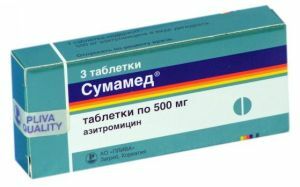
After washing the tooth cell with a solution of one of the antiseptics: Furacilin, Hexoraal, Stomatidin, Corsodil, Chlorhexidine, it contains an Alvostase sponge or iodoform-soaked turunda, which is regularly replaced at each visit to the dentist. For self-rinsing and rinsing of the dental hole, solutions of the same or other antiseptics are used.
According to the doctor's prescription, the patient takes prescribed antibiotics and makes baths with solutions of antiseptics; if necessary, treatment is supplemented with analgesics - drugs of the class of NSAIDs from the Ketorol group, Voltaren, Diclofenac, Voltaren.
Omeprazole or its analogs are used to prevent undesirable effects on the gastric mucosa during prolonged intake of NSAIDs.
Local anesthetics are appropriate for the use of Novocaine or Lidocaine, Finlexin is used to extinguish the irritation of the branches of the trigeminal nerve.
Stirring of acute inflammatory phenomena( with the need to change turundum in the hole) allows us to begin the use of Solcoseryl in the dental adhesive paste with the filling of the cavity of the cleared alveoli.
The drug has not only proven healing, but also analgesic effect. Initially, the procedure is carried out by a doctor, then the patient himself is trained to do it, with the condition of an indispensable control by the treating dentist - in case of accumulation in the detritus, it must be re-cleaned and disinfected.
Before applying the paste, the well is washed with a 0.5% solution of Chlorgexedin( rinsing or using a syringe, which makes it possible to create the pressure necessary for the effectiveness of the procedure).
Surgical treatment is an intensive local anesthetic scrubbing of pus and necrotic structures of the well and adjacent tissues.
Prevention measures
Because often osteomyelitis developing as a result of alveolitis requires the use of full-scale surgical intervention, and this is not its only complication, it is necessary to take careful measures to prevent its development.
 These should be measures aimed at preventing damage and diseases of the dentoalveolar system, strengthening bone tissues by taking necessary mineral preparations, eradicating( if this is not possible - suppressing) foci of chronic infection that can cause complications in dental procedures and interventions.
These should be measures aimed at preventing damage and diseases of the dentoalveolar system, strengthening bone tissues by taking necessary mineral preparations, eradicating( if this is not possible - suppressing) foci of chronic infection that can cause complications in dental procedures and interventions.
Treatment of chronic inflammatory and metabolic diseases also contributes to the rise of immunity, responsible for the state of tissues, organ systems and the whole organism.
When visiting a dentist, you need a thorough account of the information about the individual characteristics of your body, including previous and current treatment, and before you remove the tooth, you need to report the condition of the blood coagulation system and drug intolerance.
Special care is needed in the postoperative period. Execution of medical prescriptions from the application of cold locally to more complex procedures should have the force of law. As, however, in less stressful situations.
For the state of health of a patient's teeth, not only the attending dentist, but also the patient himself, must be responsible!
